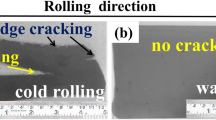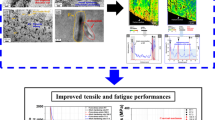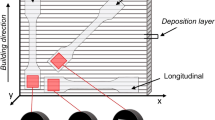Conclusions
-
1.
A composite investigation of the hardness, strength, and plasticity of the brass made it possible to more throughly study the process of deformation of the alloy in heating.
-
2.
Despite the generally similar character of change in the nominal yield strength and tensile strength in relation to temperature, the values obtained for a deformation rate of 10−4 sec−1 in the 290–900°K temperature range are higher than for a rate of more than 10−3 sec−1.
-
3.
For all of the deformation rates considered with an increase in temperature the strength and hardness of the alloy are controlled by the same mechanisms and processes respon sible for plastic deformation and successively replacing one another as for other fcc and bcc materials [9, 10, 13].
-
4.
The alloy possesses the greatest plasticity and least strength at a deformation rate of 2·10−3 sec−1, which may be preferred in setting up the production operations for working of it.
Similar content being viewed by others
Literature Cited
A. P. Smiryagin, N. A. Smiryagina, and A. V. Belova, Industrial Nonferrous Metals and Alloys [in Russian], Metallurgiya, Moscow (1974).
G. M. Kuznetsov, V. N. Fedorov, A. K. Saparov, and I. V. Bekreneva, “An investigation of phase equilibriums in the Cu−P−Zn system”, Izv. Vyssh. Uchebn. Zaved. Tsv. Met., No. 6, 57–61 (1981).
V. M. Maiorenko, V. N. Fedorov, V. M. Mozhaev, and E. V. Meinarovich, “Mathematical experiment planning in optimization of the composition of a four-component alloy for color properties”, in: Methods of Investigation of Jewelry Alloys and Questions of Standardization of Precious Metals (Proceedings of the All-Union Scientific-Research, Planning, and Design Institute for the Jewelry Industry) [in Russian], Leningrad (1982), pp. 15–19
V. P. Krashchenko and V. E. Statsenko, “A machine for investigating the strength of materials at different rates of loading in a broad temperature range”, Zavod. Lab., No. 1, 88–90 (1980).
G. S. Pisarenko, V. A. Borisenko, S. S. Gorodetskii, et al., The Strength of Refractory Metals [in Russian], Metallurgiya, Moscow (1970).
Oku Tatsuo, “The relationship between hardness and strength of materials”, Kakuyugo Kenkyu,45, No. 2, 3–13 (1981).
S. S. Vasauskas and V. Yu. Zhidonis, “The hardness curve and its use for determination of the strength characteristics of metals”, Zavod. Lab.,28, No. 5, 605–608 (1962).
A. T. Tumanov (ed.), Methods of Testing, Inspection, and Investigation of Machine Building Materials (Handbook) [in Russian], Vol. 2, Methods of Investigation of the Mechanical Properties of Metals, S. I. Kishkinaya and N. M. Sklyarov (eds.), Mashinostroenie, Moscow (1974), pp. 24–35.
V. P. Krashchenko, The Influence of Temperature-Rate Loading on the Strength of Materials. The Mechanical Properties of Metals and Alloys with a Change in Temperature and Deformation Rate [in Russian], Kiev (1981) (Preprint, Academy of Sciences of the Ukrainian SSR, Institute of Problems of Strength).
V. P. Krashchenko, The Influence of Temperature-Rate Loading on the Strength of Materials. Basic Mechanisms and Processes Determining the Strength of Metals and Alloys in Heating with Different Deformation Rates [in Russian], Kiev (1981) (Preprint, Academy of Sciences of the Ukrainian SSR, Institute of Problems of Strength).
V. A. Borisenko, “General rules of the change in mechanical properties of refractory metals in relation to temperature. Report 2. The temperature relationship of the strength of tungsten”, Probl. Prochn., No. 9, 23–31 (1975).
V. A. Borisenko, “General rules of the change in mechanical properties of refractory metals in relation to temperature. Report 1”, ibid.Probl. Prochn., No. 8, 58–63.
V. A. Borisenko and V. P. Krashchenko, “Temperature dependences of hardness of group IB metals”, Acta Met.,25, No. 3, 251–256 (1977).
Additional information
Institute of Strength Problems, Academy of Sciences of the Ukrainian SSR, Kiev. Translated from Problemy Prochnosti, No. 5, pp. 90–94, May, 1984.
Rights and permissions
About this article
Cite this article
Krashchenko, V.P., Oksametnaya, O.B., Rudnitskii, N.P. et al. Mechanical properties of aluminum-phosphorous brass in temperature-rate loading. Strength Mater 16, 717–721 (1984). https://doi.org/10.1007/BF01529056
Received:
Issue Date:
DOI: https://doi.org/10.1007/BF01529056




